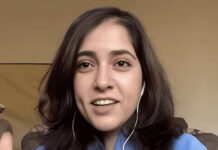
“You never know what you’re going to find until you dig. So, let’s get started.” ![]()
![]()
![]()
![]()
![]()
These were the opening words of Dr. Steven Collins, director of Veritas International University’s (VIU) School of Archeology. After giving graduate students the lay of the land, Collins began VIU’s first excavation field school in the United States.
With the Tall el-Hammam/Sodom Excavation Project in Jordan having completed its excavation phase, Dr. Collins has opened a new excavation site for training purposes: a Mimbres (N Mogollon/S Chacoan) community in central New Mexico located on private land.
Tucked in a beautiful, seeping landscape surrounded by mesas, pine, ancient riverbeds, lots of boulder gorges, and distant mountains, Dr. Collins is working with students at VIU to solve a new mystery: who were the people that inhabited this spot in New Mexico?

Prior to the dig, Dr. Collins and his team surveyed the land, finding the most likely spot of occupation. During the setting of the square on day one of the excavation—orienting the position to true north—Dr. Collins reminded students that this is a Mimbres site. And with the layers of pottery sherds found on the surface, it was likely inhabited over a three-hundred-year period, or longer.
The Mimbres were a people group occupying the Southwest, roughly between the years 200 AD—1130 AD. They were renowned for their black-on-white pottery (which is plentiful at the site). The Mimbres grew crops, hunted, and gathered plants for their sustenance. They built villages, which included kivas (social-religious structures). The Mimbres people were the pre-culture to modern Pueblo communities.

During the two-days I was at the excavation I noticed deep excitement from the students, most of which had been on excavations in the Middle East. Students arrived from all over the United States—Hawaii, Texas, Colorado, Mississippi, Arizonia, and New Mexico. The team cleared the area, measurements were made, and the slow digging process began with trowel and brush in hand. When a nice piece of pottery was found, students took time to look at it, congratulating their fellow student on their find.
As an example, after commending her upon finding two pottery sherds, Israeli-born, Irene Greene, explained to me, “These two pottery sherds are part of the same vessel, found at the same level, a surface find; but are clues to what may lie deeper.” Excitement was mounting.
More than a school field trip, this excavation fortifies deep friendships and camaraderie among students interested in people from the past, fellow human beings—separated by time and culture—but brought together through scientific study.
It’s amazing to think that a human—possibly over a thousand years ago—made and painted a pot, only to be found by fellow humans curious about their life and culture. Archeology is a time continuum shared experience, shedding light on humanity’s common quest through life.

Later, I caught up with Dr. Collins to discuss the new excavation and the excitement surrounding it.
Dr. Collins, with all the international attention given to Tall el-Hammam, why the change of direction, focusing on an American archeological site?
“Our team has been digging at Tall el Hammam since 2005, and though we’re still committed to the site, my immediate attention is turning to research, writing, and working with students to analyze the wealth of material we’ve unearthed at Tall el-Hammam. To be honest, we’ve just scratched the surface with our reporting. And to be sure, Tall el-Hammam is still my first responsibility and priority. But with the ongoing Israeli war, and the sheer expense for students to do all the Middle East fieldwork we require, it was time to establish a regional excavation site to train students in fieldwork, providing them with foundational practices in archeology, as well as learning more about the rich, ancient cultures in New Mexico. When a privately-owned landsite came to my attention, I jumped at the chance to open a field school at the site. My earliest training in anthropology at the University of New Mexico dealt with southwestern cultures, so, in a sense, I’m coming full circle. And archaeological protocols are the same whether in the Middle East or in New Mexico.”

What do you hope to discover at the new excavation?
“I’m convinced the site we’re honored to excavate is a Mimbres community, an ancient culture that lived roughly 8th to 12th century CE. Based on my initial findings of varied pottery and beads, I’m thinking the community lived in the region over a two hundred-to-three-hundred-year period.
“As far as what I expect to discover, my hunch is that it’ll be a lot of pottery sherds, possibly some beads, and hopefully some working utensils. If we’re fortunate, maybe some seeds and food items, allowing us to analyze the materials, carbon dating them for a more precise timeframe. It’d also be marvelous if we can unearth some significant architecture, like a Kiva.

“The Mimbres people were known for their black on white pottery. Just walking the area, we found scores of sherds. However, we did discover later pottery examples mixed with the Mimbres, telling me, as I stated before, that the site was occupied over a long period of time.
“Of other interest, it’d be fascinating to find some irrigation canals, giving insight into how the Mimbres people used the low rainfall in the southwest to water their crops of corn, beans, squash, and other products.”
How is biblical archeology related to other archeological sites, Mimbres included?
“In the larger sense, all archeology is Biblical archeology. That fact that God is the creator of all that is—humans included—then archeology is one channel to understand the human experience as it relates to the geography, family, religion, socio-economic factors, and environment. But unlike the Bible—or any other religious book—archeologist approach the human experience scientifically, as evidence is gathered, and conclusions are drawn based upon the substantiation of the evidence. With the evidence, comes a clearer (not perfect) picture of our shared human experience.

“As an archeologist spending most of my career in biblical, near-Eastern archeology, I’m always pleased by the common denominators all ancient cultures have: a worldview of the cosmos (religion), the basic needs for survival, the importance of family and community. We share the same basic values today.”
How will unearthing Native American archeological sites help students understand the larger archeological record, connecting it to biblical archeology and world archeology?
“Though the Mimbres lived a few thousand years later than the people at Tall el-Hammam, as I stated, there are common features one culture to another regardless of time and geography.
“At Tall-el Hammam we find evidence for the building blocks of a robust working community—pottery, housing, religion, and the like; the same features we’re finding at our Mimbres site. Of course, at Tall el-Hammam we’ve found extraordinary evidence for an airburst event that caused a long-term destruction of the region; I don’t think we’ll find any definite proof of what caused the Mimbres people to leave the area, minus the working hypotheses that it was due to a long-term drought or possibly internal, religious factions and waring.

“But as mentioned before, I see all forms of archaeology as interconnected, a web of human relations, migrations, affected by a host of factors—environment, human, and sociological interactions. And from the point of view as a theist, part of God’s providential plan for Earth.”
As you are aware, recent studies of footprints in the region theorize that humans were in North America up to 30-thouasand years ago. How does this square with what you’ve discovered in the Middle East?

“Yes. I’m well aware of the recent findings released by Scientific American and other outlets. With more testing, the evidence will mount and change our understanding of the human presence in the US, and New Mexico in particular. All over the world evidence is mounting that high (architectural) human culture goes back far, far earlier than conventional wisdom has typically informed us.
“From a biblical standpoint, the evidence found in New Mexico only collaborates what we’re finding in the Middle East, pointing to an extremely ancient earth with the presence of humans eventually inhabiting virtually the entire planet, creating cultures and leaving (pun intended) footprints for others—like me and my colleagues—to study, interpret, and publish for future generations.
It’s all very exciting.”



